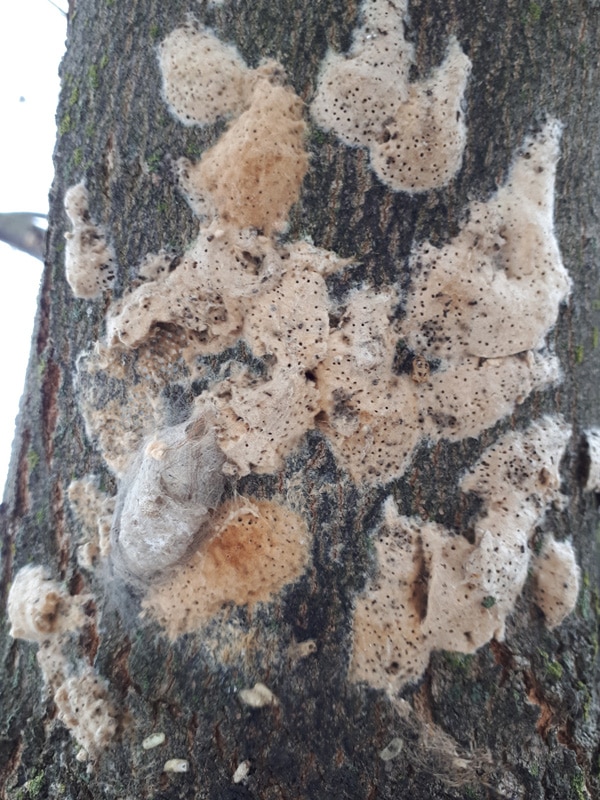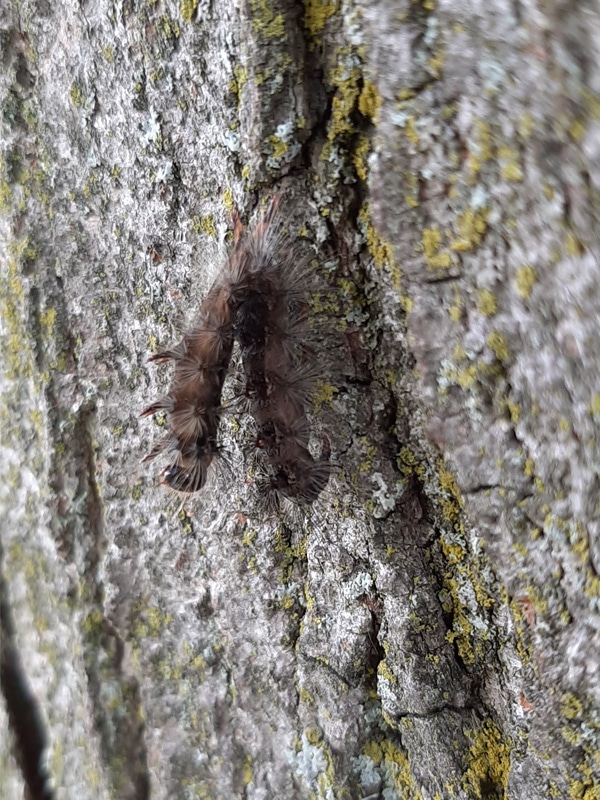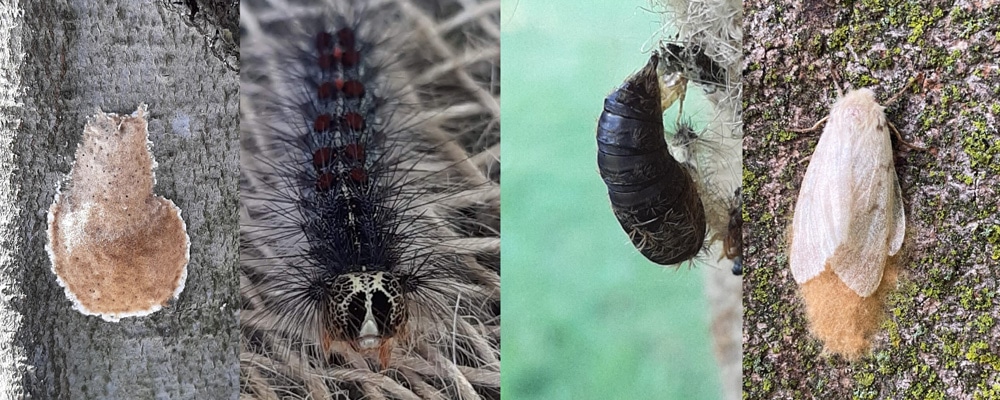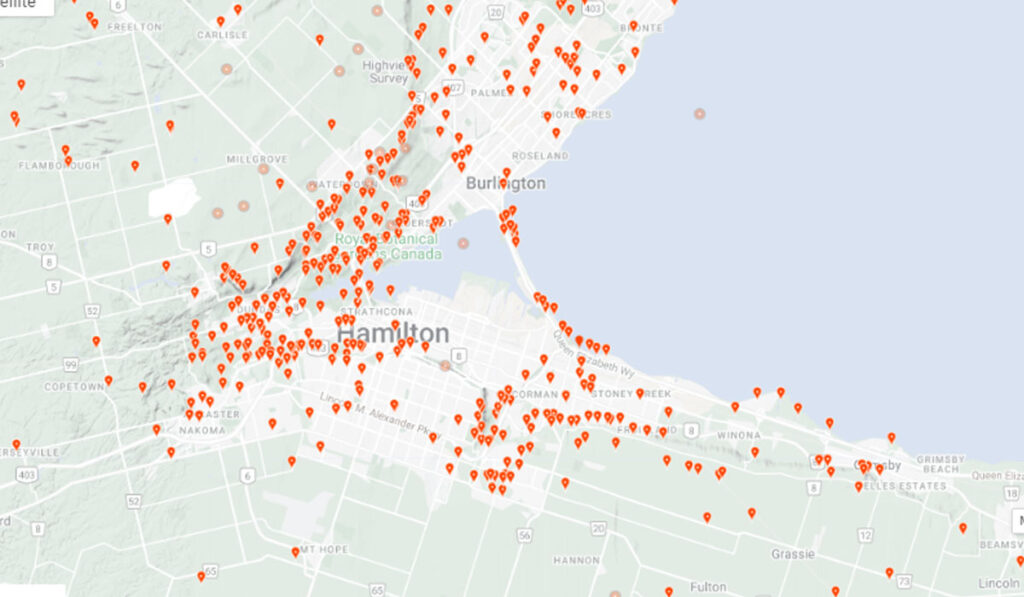What is the Spongy Moth?
Spongy Moth, also known as LDD Moth (Lymantria dispar dispar), and formally known as Gypsy Moth*, is a non-native European insect that was first detected in Ontario in the late 1960s and is now well established in Southern Ontario.
Spongy moth caterpillars are known to feed on the leaves of variety of trees and shrubs. Their favourite species are oak, black cherry, apple, white birch and beech. They will also consume other deciduous species like maples, willows, ironwood and poplar, and evergreen species like pine and spruce.
Where did they come from?
First introduced to North America in the late 1860s by French naturalist Etienne Leopold Trouvelot, who imported Spongy Moths from Europe. He lived in Massachusetts and was hoping to create a silk industry in the United States.
Trouvelot began experimenting with native silk worms at his home, but wasn’t happy with his results. He needed a species that could tolerate being handled, ate a variety of local vegetation and had no predators. The Spongy moth checked all the boxes, but didn’t produce quality silk. He then created a hybrid by crossing Spongy moth with the North American silk worm. When his experiment failed, he abandoned them, and Spongy moths spread rapidly.
How to Identify Spongy Moth in its various Life stages
Spongy Moth has four life stages: egg, larva (caterpillar), pupa and adult (moth).
Egg Masses
Egg masses are fuzzy, hard, tan to orange in color and can get up to 7cm in size. Each egg mass may contain anywhere between 100 – 1000 eggs depending on the size of the egg mass. Egg masses are most noticeable during winter months when the trees have shed their leaves, and can be found individually along the entire tree or in clumps under branches.
Larva (Caterpillar)
 Very small black caterpillars, about 2mm in size, emerge from the egg mass in April and start moving around very quickly looking to feed. These small caterpillars use a technique called ‘ballooning’ which allows them to travel even further using wind currents. When the opportunity is right, small caterpillars will dangle from trees on a silk thread allowing the breeze to take them to new places. If you are traveling outdoors around this time, you might notice these hitchhikers crawling on your clothes. These small caterpillars are covered in hairs called 'setae' and exposure to skin may cause allergic reactions in some individuals.
Very small black caterpillars, about 2mm in size, emerge from the egg mass in April and start moving around very quickly looking to feed. These small caterpillars use a technique called ‘ballooning’ which allows them to travel even further using wind currents. When the opportunity is right, small caterpillars will dangle from trees on a silk thread allowing the breeze to take them to new places. If you are traveling outdoors around this time, you might notice these hitchhikers crawling on your clothes. These small caterpillars are covered in hairs called 'setae' and exposure to skin may cause allergic reactions in some individuals.
Caterpillars grow by molting in stages called instars. In early instars (1-3) caterpillars will feed during the day and when temperatures are high their activity decreases and look to rest in shade. By the fourth instar, caterpillars will change their behavior by feeding at night and taking shelter during the day to avoid predators.
Spongy Moth Caterpillar vs. Other Native Caterpillars
As the caterpillars feed and grow they will get larger in size and have a distinctive yellow and black head with five pairs of blue spots, followed by six pairs of red spots down the back of their body. The blue and red spots down the back is a key feature, because there are other caterpillars such as the tent caterpillar that look similar but lack this distinctive marking. Please see Michigan State University for a good comparison between native tent caterpillars and Spongy moth caterpillars.
Pupa
In July, the caterpillars will begin to look for a safe space to pupate. They look for hiding spaces in cracks and folds of tree bark, under branches, in crevices of firewood, on buildings and even patio furniture. They stay in this stage for about a week or two until they are ready to emerge as an adult moth.
Adults (Moths)
Female and male moths do not spend time feeding and their main purpose for roughly two weeks in August is to mate, then reproduce. Female and male moths are sexually dimorphic (different in size and color). Male moths are the first to emerge; brown in color, with large, feathery antennae. Unlike other moths that are typically active during dusk and night, male Spongy moths are most active during the afternoon. They are not great at flying and are very noticeable fluttering around in a forest with a heavy infestation.
Female moths emerge after the males; they are white with a dark V shape on their forewings and do not fly. Males use their large antennae to ‘smell’ where females are by picking up on pheromone trails that the females give off. Once a female mates, she will only lay one egg mass. These egg masses can differ in size and contain various numbers of eggs.
When a high proportion of egg masses are small in size, it generally means that the population is decreasing. If a high proportion of egg masses are large in size, it generally means that the population is doing well and there will be heavy defoliation in the following year. Counting the quantity of egg masses is also used in surveys to determine the population size and predicted defoliation.
Natural Predators
Spongy moths have natural predators such as insects, mammals, birds, parasitoids and pathogens (fungus and virus) that helps to naturally control the population.
Birds, Mammals & Insects
Birds: Bird species such as the Yellow-billed and Black-billed Cuckoos, Orioles and Blue Jays will eat the caterpillars while black-capped chickadees will feed on the egg masses.
Mammals: Small mammals such as squirrels, voles, shrews and mice will feed on the pupae.
Insects: Introduced and native insects and arachnids such as beetles, stinkbugs, spiders, ants will also feed on Spongy moths at various life stages.
Parasitoid Wasp and Flies
Parasitoid wasps and flies are an important and effective biological control to high populations of Spongy moths. They will carry out their entire lifecycle on Spongy moth caterpillars or egg masses.
The Ooencyrtus kuvanae is an introduced species of wasp that specializes in parasitizing on Spongy moth egg masses. These tiny black wasps can have three generations in one year (Summer, Fall, Spring). The wasps emerge creating small round exit holes which are noticeable on Spongy moth egg masses.
Pathogens
There are two main pathogens that help control population of Spongy moths: NPV Virus Disease and Fungus Disease.
NPV Virus Disease
The NPV(nucleopolyhedro virus) virus disease only affects Spongy moths and is highly successful at reducing the Spongy moth population. The NPV virus works well when there is an outbreak and the population is stressed by competition for food and space. Caterpillars that have the virus will hang in an upside-down V shape.
Fungus Disease
The fungus Entomophaga maimaiga was introduced to the United States and lives in the soil. Unlike the NPV virus disease that does particularly well in outbreaks, the fungus is effective even when population of Spongy moth is low. If a caterpillar is infected with this fungus, it will die stiff and shriveled, hanging upside down. When their bodies fall to the ground the fungus spores are returned back to the soil.
 Parasitic Wasp Exit Holes
Parasitic Wasp Exit Holes NPV Virus
NPV Virus Fungus Disease
Fungus Disease
How can you control Spongy Moths at home?
The treatments we use today, have been used since the 1860s. These include hand picking, burlaping, pheromone trapping, sticky banding, biological control and herbicide treatments.
A simple way to help control Spongy moths at home, is to hand pick egg masses and burlap your tree.
Hand Picking Egg Masses
The best time to scrape Spongy egg masses is in winter when parasitic wasps have carried out their lifecycle. You want to scrape Spongy egg masses into a bucket of soapy water and leave it for at least 24 hours before discarding.
Burlap Your Tree
By the end of April, you can start to burlap your trees. Check under your burlap at least once a week for caterpillars, remove them into a bucket of soapy water and leave it for at least 24 hours before discarding. When checking your burlap for caterpillars, encourage the spread of NVP virus disease and fungus disease by leaving caterpillars that show evidence of being affected. Small white-yellow cocoons is evidence of parasitoid pupas from other species of wasps and flies and should also not be removed.
*In 2021, the Entomological Society of America (ESA) removed ‘gypsy moth’ as a recognized common name to Lymantria dispar (LDD), and then in 2022 to Spongy Moth. ESA is reviewing and replacing names that may be inappropriate or offensive because they perpetuate negative ethnic or racial stereotypes. HCA will be transitioning our materials to reflect these changes as well.
Resources
Planning a Spongy Moth Management Program Factsheet
LDD Moth Ecology and Management Options Webinar
Sources








